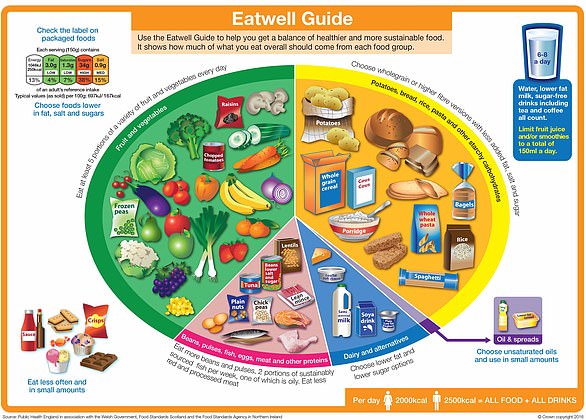Generation UPF: British teenagers now get TWO-THIRDS of their daily calories from ultra-processed foods, shocking new data reveals – as diabetes and obesity in under-40s continue to rise
Research shows that British teenagers get two-thirds of their daily calories from ultra-processed foods.
White children and children from disadvantaged backgrounds consume the most UPFs, which are often mass-produced and often contain high levels of salt, saturated fat and sugar.
The study found that young people between the ages of 11 and 18 got an average of 66 percent of their calories from these foods, leaving little room for more nutritious foods.
According to experts, this trend is particularly worrying because these are the years when habits can take hold.
The research from the Universities of Cambridge and Bristol looked at the diets of 3,000 children who took part in the UK National Diet and Nutrition Survey between 2008/09 and 2018/19.
An easy sign that a food could be a UPF is if it contains ingredients that you wouldn’t find in your kitchen cupboard, such as unrecognisable dyes, sweeteners and preservatives. Another clue is the amount of fat, salt and sugar that is in each package, with UPFs typically containing high amounts
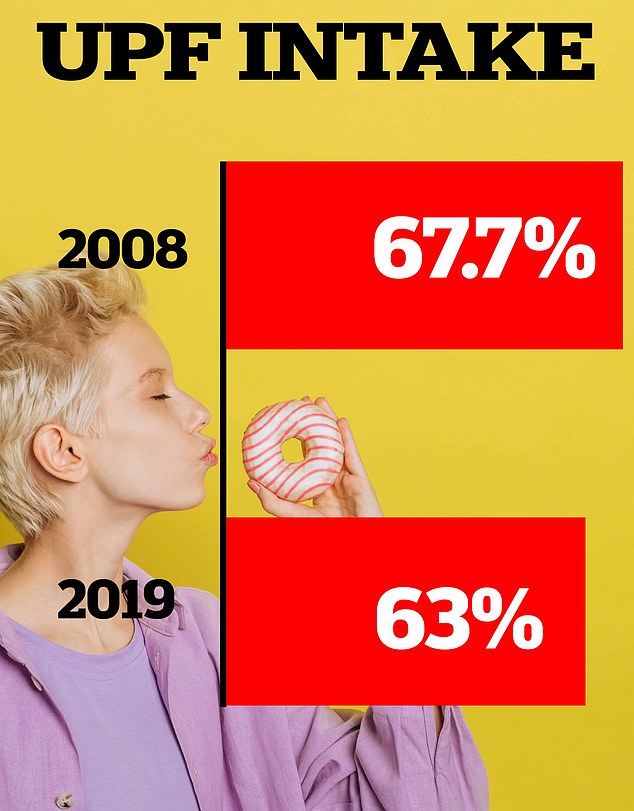
A graph from MailOnline showing children’s intake of ultra-processed foods in 2008 and 2019
For four days they kept a food diary, recording what they ate and drank, both inside and outside the home.
Products such as processed meat, chips, mass-produced bread and breakfast cereals have been linked to an increased risk of diseases such as obesity, type 2 diabetes and heart disease.
UPFs also often contain additives and ingredients that people don’t often use when cooking, such as preservatives, emulsifiers, and artificial colors and flavors.
It was found that parental occupation, ethnic group and region in the UK all influence adolescent diet.
The average UPF consumption was 861 grams per day, or 66 percent of daily energy intake over the period.
Looking over time, we see that intake has decreased slightly from 67.7 percent in 2008 to 63 percent in 2019.
According to researchers, this is due to the increasing number of health campaigns to eat less sugary or fatty foods, as well as the UK government’s sugar tax, which has reduced the amount of sugar in drinks.
Analysis found that people living in the north of England get a higher proportion of their calorie intake from UPFs than those living in the south, at 67.4 and 64.1 per cent respectively.
According to the findings published in the European Journal of Nutrition, consumption was highest at the start of secondary school, at 65.6 percent, before declining slightly to 63.4 percent at age 18.
This compares to one in four children in England being obese by the time they leave primary school.
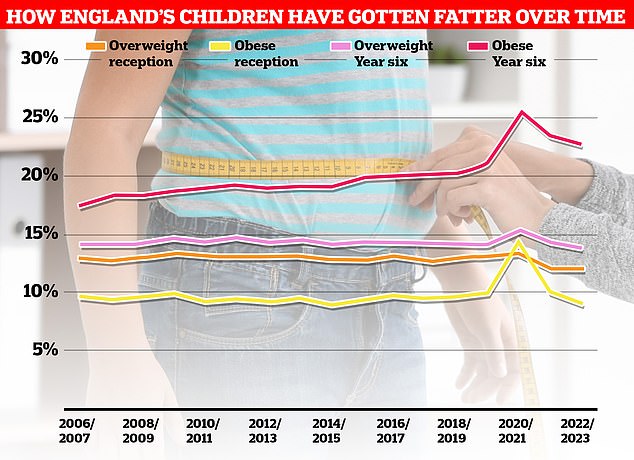
More than a million children have had their height and weight measured under the National Child Measurement Programme (NCMP). Nationally, the rate among children in Year 6 is more than a third, despite falling slightly since Covid began.
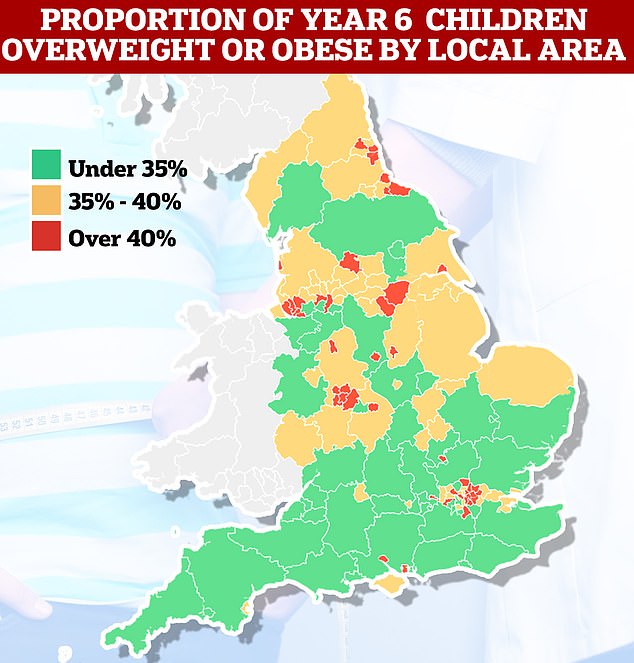
Among Year 6 pupils, national obesity fell from 23.4 per cent in 2021/22 to 22.7 per cent. Meanwhile, the percentage of children considered overweight or obese also fell from 37.8 per cent to 36.6 per cent. Both measures are above pre-pandemic levels.
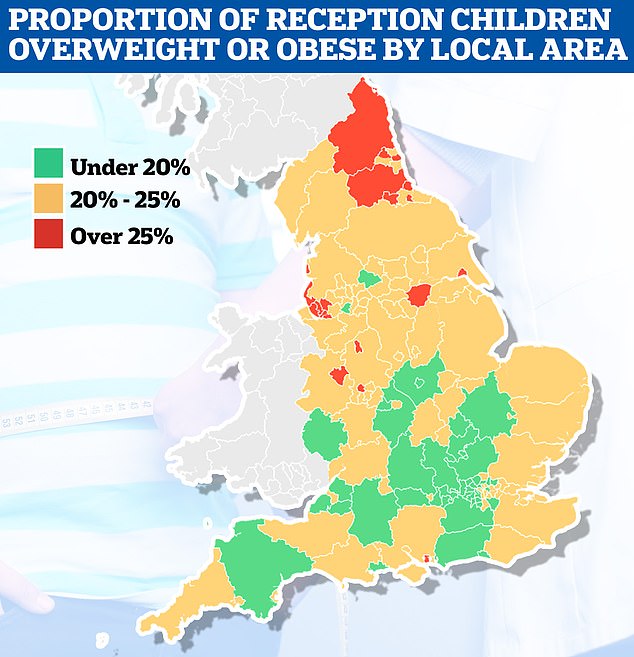
A graph showing the percentage of overweight or obese children in care by local area
Dr Yanaina Chavez-Ugalde from the University of Cambridge said: ‘Adolescents’ eating habits and behaviours are influenced by many factors, including their home environment, the marketing they are exposed to and the influence of their friends and peers.
‘But adolescence is also an important period in our lives when certain behaviors begin to develop.
‘Our findings clearly show that the majority of adolescents’ diets consist of highly processed foods, with consumption levels far exceeding ideal levels given their potential negative health consequences.’
People from disadvantaged backgrounds had the highest calorie intake from UPFs, at 68.4 percent, compared to 63.8 percent among wealthier peers.

More than one in five children are now obese when they leave primary school, the highest rate ever
Researchers, funded by the National Institute for Health and Care Research, say more needs to be done to tackle the problem.
Dr Esther van Sluijs, also from Cambridge, said: ‘Ultra-processed foods are a convenient and often cheaper solution for families with limited time and money, but unfortunately many of these foods also have poor nutritional value.
“This could contribute to the health inequalities we see emerging during childhood and adolescence.”
Dr Carmen Piernas-Sanchez, a nutrition scientist at the University of Oxford who was not part of the study, said the results reflect a global trend.
She said: ‘Similar figures have been reported in other countries, such as the US. This study provides the latest estimates of UPF consumption in adolescents and offers some evidence of differences between age groups, regions, ethnicities and socioeconomic status (SES) groups.
‘Future studies of this type should report which food sources contribute most to UPF consumption. This could further inform policies aimed at improving the diet quality of the UK population.’

